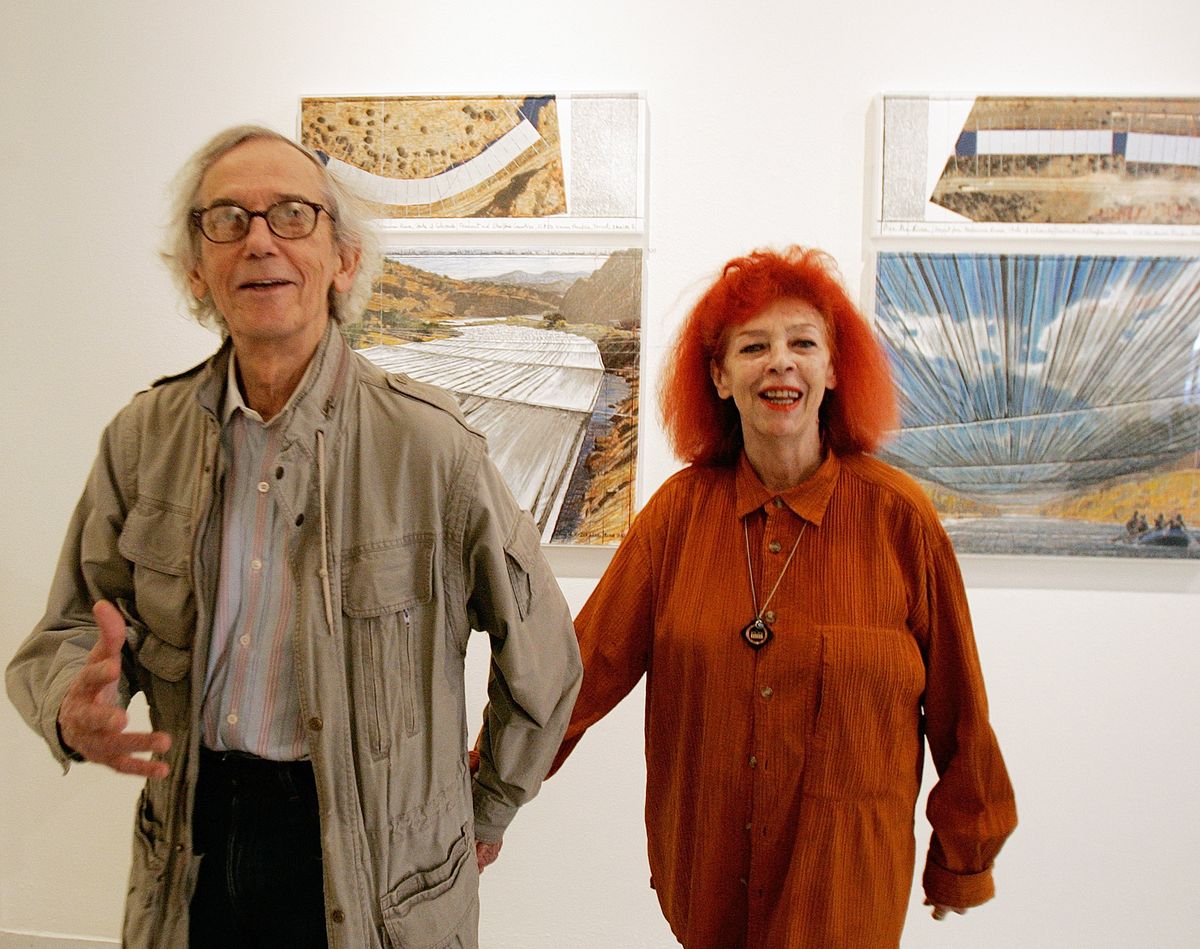‘Over The River’ sits on waiting list
Artists’ project on hold until permit is OK’d

DENVER – Christo and Jeanne-Claude conceived the idea of suspending huge swathes of fabric over a river back in 1992. The artists scouted dozens of Western locations before settling on a mountainous stretch of the Arkansas River, a Southern Colorado playground for whitewater rafters in view of old U.S. Highway 50.
The couple, both 73, are still waiting for a Bureau of Land Management permit to install their “Over The River” project.
“The process of getting the permit is part of the work of art,” said Jeanne-Claude, her red-orange hair matching her bright lipstick. “To put it in human terms, the process is a little a bit like the nine-month pregnancy. It’s part of having the baby.”
In the interim, the couple realized years-old dreams of temporarily wrapping Germany’s parliament building, the Reichstag, in more than 1 million square feet of polypropylene fabric, and erecting thousands of fabric panels along paths in New York’s Central Park. Both took long waits for permission.
At the earliest, “Over The River” could be completed in 2012 – and it would last just two weeks. Christo and Jeanne-Claude’s team estimates total costs at $50 million, funded by the artists and sales of their works.
The Phillips Collection in Washington plans to show “Christo and Jeanne-Claude: Over The River, a Work in Progress” from Saturday to Jan. 25, to display what the artists envision and the materials they plan to use over the Arkansas. Interior Department officials and Colorado’s congressional delegation have been invited.
The New York-based artists, known for outdoor pieces combining elements of landscapes, architecture and sculpture, also are showing images of future projects at Metropolitan State College of Denver’s Center for Visual Art through Nov. 1. Some represent dreams, such as wrapping New York’s One Times Square with fabric, that may never be realized.
“Over the River” marks a return to Colorado, where they erected the Valley Curtain – 142,000 square feet of orange nylon fabric strung across a highway near the western town of Rifle – in 1972.
The artists plan to suspend silvery fabric, stretching a total of nearly 6 miles, from the quaint town of Salida to Canon City, about 100 miles south of Denver. Kayakers and river walkers would peer at the clouds through the fabric as they pass underneath. From U.S. 50, travelers would see the sky reflected on the cloth.
About 34 miles of that section of the river, which includes a rail line, would not be covered.
“My first impression was it’s one of the most difficult projects we’ve ever done just because of the logistics, the proximity to the highway, the railroad, and just the accessibility,” said director of construction Vince Davenport, who helps engineer the couple’s ideas.
The project requires wind tests and safety precautions.
The artists’ “The Umbrellas,” in which 3,100 blue and yellow umbrellas were planted simultaneously on hillsides in Japan and California in 1991, led to two deaths. A woman was pinned when wind uprooted a nearly 450-pound umbrella in California, and a worker in Japan was electrocuted during dismantling of the piece.
In Colorado, Christo and Jeanne-Claude say they are prepared to answer concerns about safety and effects on wildlife, traffic and rafting as they wait for a yet-to-be-named independent party to prepare an environmental impact statement for the Bureau of Land Management. That process could take up to two years.
While tourism officials support the project, others call the artists vandals and arrogant.
“What could covering up a river possibly do to improve a beautiful river,” one resident wrote on a BLM online record of comments.
Jeanne-Claude said she and her husband are accustomed to opposition and that people are afraid of the unknown.
“To experience our project is not like here, looking at things,” Christo said in a recent interview at the Center for Visual Art in Denver. “You need to spend time, walk a few hundred meters, like to be in the sun, in the snow and the rain and the wind.
“In a museum, it’s warm and nice, it’s air conditioned, you talk not too loud to be polite. But this project, they’re (the elements) around you. They’re woven in that space.”
Christo brought up “The Gates,” the 2005 Central Park project that lasted 16 days.
“One gate is not a work of art. Two gates is not a work of art; 7,503 gates in 23 miles in Central Park with the skyline of Manhattan in Central Park, all that is a work of art,” Christo said.
“If you look at what human beings do on planet Earth with airports, highways, skyscrapers, our work is not that big,” Jeanne-Claude added.
The artists also are working on a concept called “The Mastaba,” a bench-shaped forerunner of the pyramid, that would be located in the United Arab Emirates. The $500 million project, conceived in 1977, would involve stacking more than 400,000 oil barrels nearly 500 feet high, Davenport said.
While that installation would be permanent, the fleeting nature of the couple’s other multimillion-dollar works is part of the art, playing on the love and tenderness people feel for things like childhood that do not last, Jeanne-Claude explained.
“Those who see our work, they will tell their grandchildren, ‘I was there, I saw it,’ ” she said. “We love the words, ‘Once upon a time.’ ”